Fossil trackway
A fossil trackway is a type of trace fossil, a trackway made by an organism. Many fossil trackways were made by dinosaurs, early tetrapods, and other quadrupeds and bipeds on land. Marine organisms also made many ancient trackways (such as the trails of trilobites and eurypterids like Hibbertopterus).
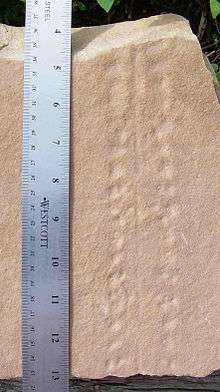
Some basic fossil trackway types:
The majority of fossil trackways are foot impressions on land, or subsurface water, but other types of creatures will leave distinctive impressions. Examples of creatures supported, or partially supported, in a water environment are known. The fossil "millipede-type" genus Arthropleura left its multi-legged/feet trackways on land.
Hominid trackways
Africa
Tanzania
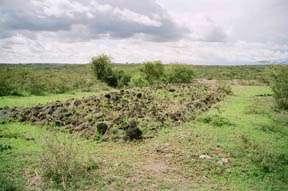
Some of the earliest trackways for human ancestors have been discovered in Tanzania. The Laetoli trackway is famous for the hominin footprints preserved in volcanic ash. After the footprints were made in powdery ash, soft rain cemented the ash layer to tuff, preserving the prints. The hominid prints were produced by three individuals, one walking in the footprints of the other, making the original tracks difficult to discover. As the tracks lead in the same direction, they might have been produced by a group — but there is nothing else to support the common reconstruction of a nuclear family visiting the waterhole together.
South Africa
In South Africa, two ancient trackways have been found containing footprints, one at Langebaan and one at Nahoon. Both trackways occur in calcareous eolianites or hardened sand dunes. At Nahoon, trackways of at least five species of vertebrates, including three hominid footprints, are preserved as casts.[2] The prints at Langebaan are the oldest human footprints, dated to approximately 117,000 years old.[3]
Australia
New South Wales
Twenty six human fossil trackways have been found in the Willandra Lakes area adjacent to Lake Garnpung, consisting of 563 human footprints from 19,000 to 20,000 years ago.[4]
Early Tetrapod
The earliest land creatures (actually land-marine coastal-riverine-marshland) left some of the first terrestrial trackways. They range from tetrapods to proto-reptilians and others.
A possible first connection of a trackway with the vertebrate that left it was published by Drs. Sebastian Voigt and David Berman and Amy Henrici in the 12 September 2007 issue of Journal of Vertebrate Paleontology. The paleontologists who made the connection were aided by unusually detailed trackways left in fine-grained Lower Permian mud of the Tambach Formation in central Germany, together with exceptionally complete fossilised skeletons in the same 290-million-year-old strata. They matched the two most common trackways with the two most common fossils, two reptile-like herbivores known as Diadectes absitus (with the trackway pseudonym Ichniotherium cottae) and Orobates pabsti (with the trackway pseudonym of Orobates pabsti).[5]
The Permo-Carboniferous of Prince Edward Island, Canada contains trackways of tetrapods and stem-reptiles.[6] Macrofloral and palynological information help date them.
Ireland hosts late Middle Devonian tetrapod trackways at three sites on Valentia Island within the Valentia Slate Formation.[7][8]
The earliest fossil trackway of primitive tetrapods in Australia occurs in the Genoa River Gorge, Victoria, dating from the Devonian 350 million years ago.[9]
Dinosaur trackways

Dinosaurs lived on the continents before grasses evolved (the "Age of the Grasses" evolved with the "Age of the Mammals"); the dinosaurs lived in the Triassic, Jurassic, and Cretaceous and left many trackways, both from plant-eaters and the meat-eaters, in various layers of mud and sand.
With scientific analysis, dinosaur specialists are now analyzing tracks for the walking-speeds, or sprint-running speeds for all categories of dinosaurs, even to the large plant eaters, but especially the faster 3-toed meat hunters. Evidence of herding, as well as pack hunting are also being investigated.
Brazil
- Valley of the Dinosaurs, Paraíba, Brazil
Africa
Zimbabwe
An example trackway from Africa is a trackway in 140 Ma rose-coloured sandstone of Chewore Area, Lower Zimbabwe Rift Valley.[10] The small footprint size, with both manus and pes implies that it is a trackway of a juvenile, a probable carnosaur.
North America
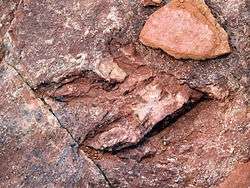
The western regions of North America, especially the western border of the Western Interior Seaway, are common for dinosaur trackways. Wyoming has dinosaur trackways from the Late Cretaceous, 65 ma.[11] (A model example of this 3-toed Wyoming trackway was made for presentation.)[12]

In the United States, dinosaur footprints and trackways are found in the Glen Rose Formation, the most famous of these being the Paluxy River site in Dinosaur Valley State Park. These were the first sauropoda footprints scientifically documented, and were designated a US National Natural Landmark in 1969. Some are as large as about 3 feet across. The prints are thought to have been preserved originally in a tidal flat or a lagoon.[13] There are tracks from two types of dinosaur. The first type of tracks are from a sauropoda and were made by an animal of 30 to 50 feet in length, perhaps a brachiosaurid such as Pleurocoelus,[13] and the second tracks by a theropoda, an animal of 20 to 30 feet in length, perhaps an Acrocanthosaurus. A variety of scenarios was proposed to explain the tracks, but most likely represent twelve sauropods "probably as a herd, followed somewhat later by three theropods that may or may not have been stalking -- but that certainly were not attacking." [13]
- Dinosaur tracks, near Moab, Utah[14]
- Dinosaur Footprints Reservation in Holyoke, Massachusetts, USA
- Red Gulch Dinosaur Tracksite, Wyoming
- Prehistoric Trackways National Monument near Las Cruces, New Mexico
- Connecticut River Valley trackways, in New England
- Clayton Lake State Park dinosaur trackway near Clayton, New Mexico
China
The Gansu dinosaur trackway located in the Liujiazia National Dinosaur Geopark in Yanguoxia, China contains hundreds of tracks including 245 dinosaur, 350 theropod, 364 sauropod and 628 ornithopod tracks among others.[15]
Mammal trackways
Mammal trackways are among the least common trackways. Mammals were not often in mud, or riverine environments; they were more often in forestlands or grasslands. Thus the earlier tetrapods or proto-tetrapods would yield the most fossil trackways. The Walchia forest of Brule, Nova Scotia has an example of an in situ Walchia forest, and tetrapod trackways that extended over some period of time through the forest area.
United States
Gallery
 A carnivorous theropod trackway, near Enciso, La Rioja, Spain
A carnivorous theropod trackway, near Enciso, La Rioja, Spain
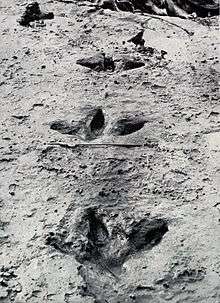 Moa footprints near the Manawatu River, New Zealand.
Moa footprints near the Manawatu River, New Zealand.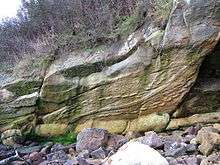 Hibbertopterus trackway: negative relief image, a groove infilled by sand appears as a ridgeline
Hibbertopterus trackway: negative relief image, a groove infilled by sand appears as a ridgeline
See also
| Wikimedia Commons has media related to Trackways fossils. |
| Wikimedia Commons has media related to Trace fossils. |
References
- Stössel, I, Williams, E.A. & Higgs, K.T. 2016. Ichnology and depositional environment of the Middle Devonian Valentia Island tetrapod trackways, south-west Ireland. Palaeogeog., Palaeoclimatol., Palaeoecol., 462, 16–40
- Last Interglacial Hominid and Associated Vertebrate Fossil Trackways in Coastal Eolianites, South Africa, 2008
- South Africa West Coast article on Langebaan footprints
- Westaway, Michael C.; Cupper, Matthew L.; Johnston, Harvey; Graham, Ian (June 2013). "The Willandra Fossil Trackway: Assessment of ground penetrating radar survey results and additional OSL dating at a unique Australian site". Australian Archaeology (76): 84–89. JSTOR 23621961.
- Science Daily, "Who Went There? Matching Fossil Tracks With Their Makers", 15 September 2007.
- Calder, J.H., Baird, D. & Urdang, E.B. 2004. On the discovery of tetrapod trackways from Permo-Carboniferous redbeds of Prince Edward Island and their biostratigraphic significance. Atlantic Geology, 40, 217–226.
- Stössel, I. 1995. The discovery of a new Devonian tetrapod trackway in SW Ireland. J. Geol. Soc. Lond. 152, 407–413.
- Stössel, I, Williams, E.A. & Higgs, K.T. 2016. Ichnology and depositional environment of the Middle Devonian Valentia Island tetrapod trackways, south-west Ireland. Palaeogeog., Palaeoclimatol., Palaeoecol., 462, 16–40
- Warren, J.W. & Wakefield, N.A., 1972. Trackways of tetrapod vertebrates from the Upper Devonian of Victoria, Aust. Nature 238, 469-470.
- "Walking with baby dinosaurs", manus and pes prints
- Dinosaur Hunting in Wyoming, photo: Arlene and Gabe at the trackways.
- Dinosaur Hunting in Wyoming, photo: trackways for presentation.
- Martin Lockley & Adrian P. Hunt, Dinosaur Tracks and Other Fossil Footprints of the Western United States, Columbia U. Press, New York (1995)
- Area with 200-plus dinosaur tracks opening to public soon accessdate=2014-08-25
- Fujita, Sato; Lee, Yuong-Nam; Azuma, Yoichi; Li, Daqing (2012). "Unusual Tridactyl Trackways with Tail Traces from the Lower Cretaceous Heikou Group, Gansu Province". PALAIOS. 27 (8): 560–570. doi:10.2110/palo.2012.p12-015r. JSTOR 41692731.
- Unrivalled fossil find, The Cola Herald
External links
- Wyoming 3-toed trackways
- Zimbabwe juvenile dinosaur trackway
- Redbeds of Prince Edward Island, Permo-Carboniferous
Dinosaur trackways:
- Photo-High Res--(Outdoor photo); Article Photo from Dakota Formation, Colorado, USA
Early Tetrapods:
Australia
